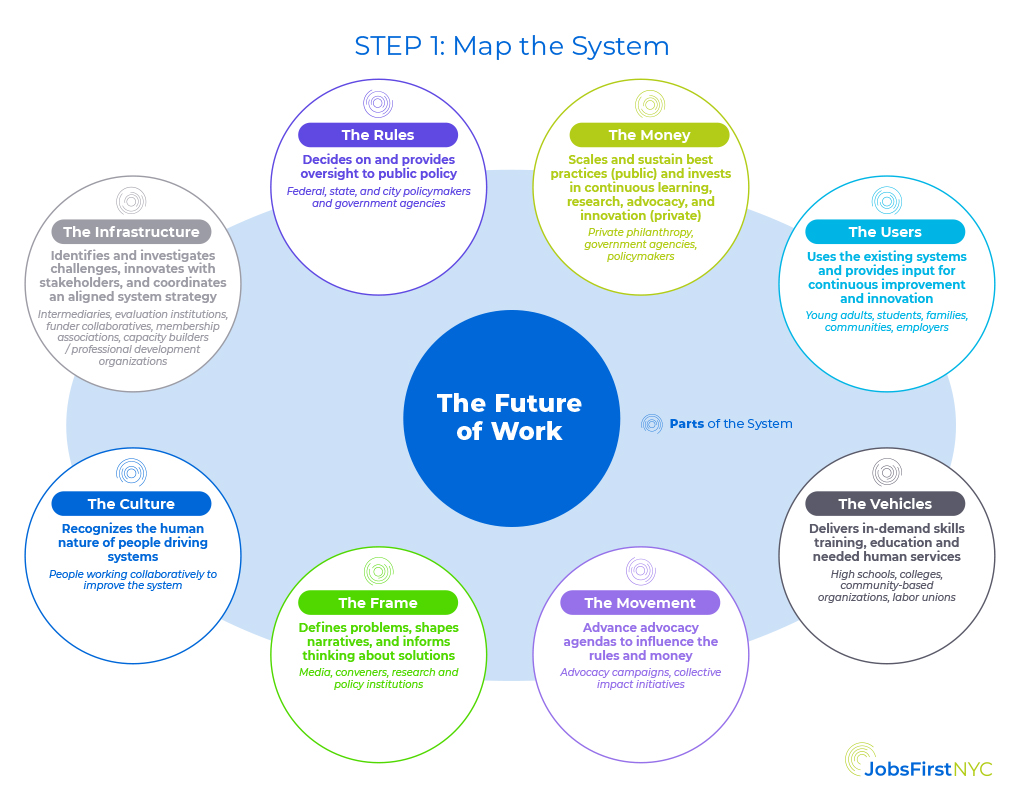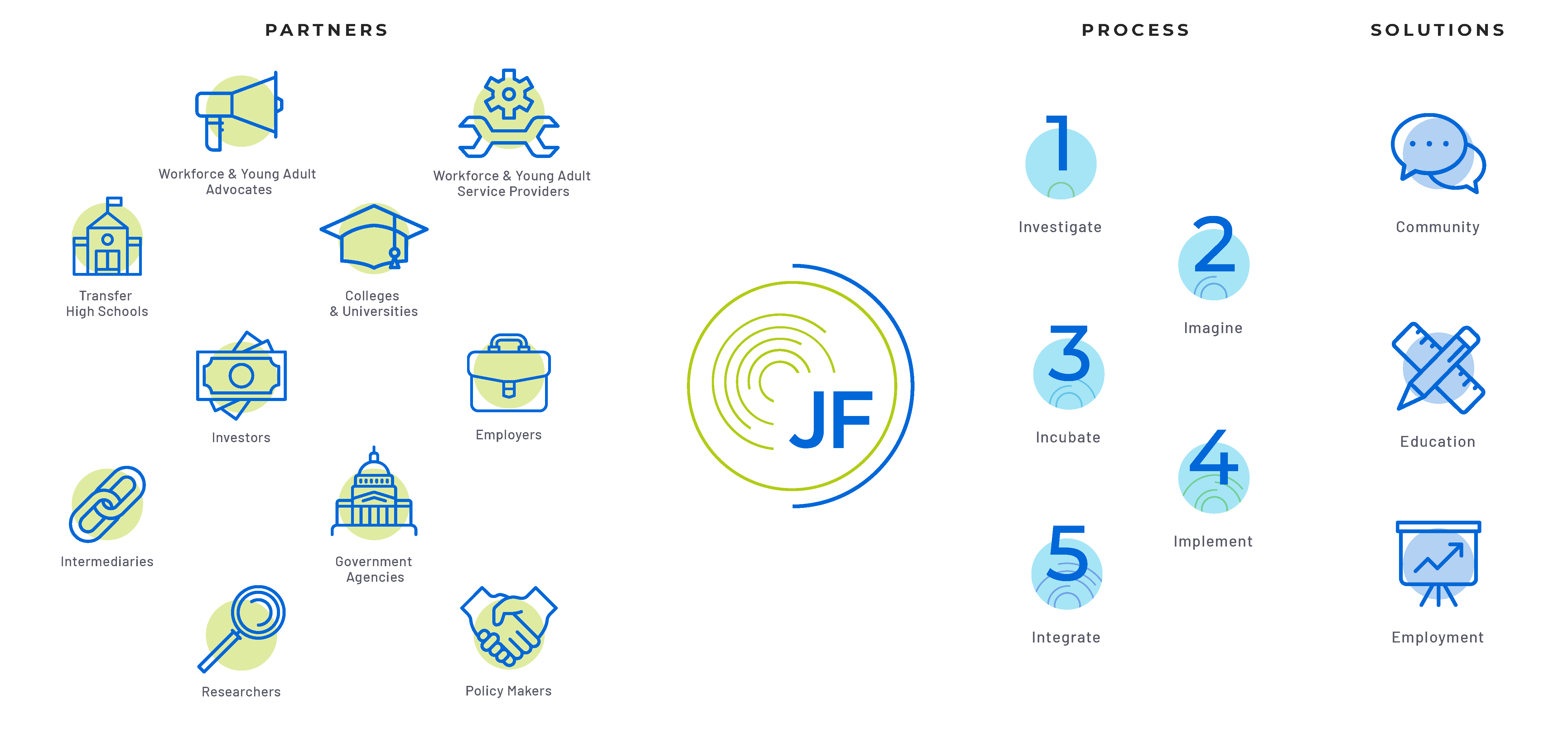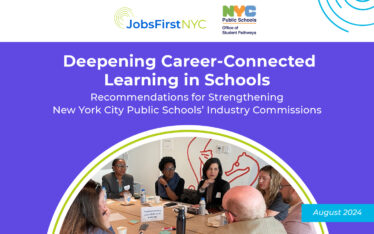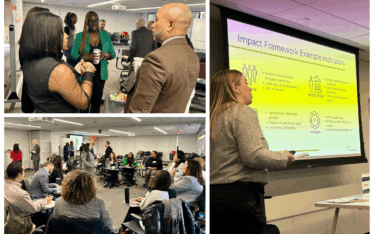As Mayor de Blasio’s tenure comes to an end and the 2021 mayoral hopefuls begin to campaign in earnest, we have more work than ever to do to ensure that their visions for New York City include a paradigm shift for how we will prepare rising generations for an increasingly changing and demanding economy. With the backdrop of high unemployment and fiscal challenges caused by the pandemic-induced recession, this is a unique moment that requires us to think differently about the systems designed to support young adults.
However, to be clear, the systems-change we seek is long-term and requires more than mayoral leadership or policy reforms. It requires a multi-stakeholder approach across all the parts of a system that leverages the inflection point of a new mayor in the context of a new economic reality. This means we all need to organize our collective change efforts towards a more aspirational future that can better prepare tomorrow’s workforce for a 21st century economy.
This requires a clear understanding of today’s status quo system, a clear vision for what could be, and a collaborative framework for change.
Today, we as a city still do not have workforce and post-secondary education goals to meet current and potential demand; we do not have a basic data-infrastructure to help connect supply with demand; we do not have a shared definition of success; and we have steadily eroded and suffocated the very institutions (i.e. community-based non-profits, public colleges) that are the backbone of realizing change. Programs contracted through city agencies, administered by community institutions on the ground, have restricted capacity and collective community infrastructure, limiting the ability to respond to the rapidly changing issues too many New Yorkers face in climbing their own ladder of economic mobility. Intermediaries working across education, youth, workforce and economic development do not have a shared strategy or organizing infrastructure. Private funders lack a cohesive approach to realizing and sustaining innovation and systems change, and research institutions lack a coordinated research agenda. Taken together–our general uncoordinated vision, lack of follow-through, myopic infrastructure, and an under-invested systems strategy compounded with a rapidly shape shifting economy–creates the perfect storm.
Despite a changing context and these growing concerns, there has been much progress made over the last era that we can build on in the years to come. High School graduation rates have steadily increased as schools improved and interventions like Transfer Schools and Young Adult Borough Centers matured, among others, helping those with deep academic challenges complete high school. There have also been some innovative new models to connect young adults to economic opportunities that do not require a college degree, such as JobsFirstNYC’s Young Adult Sectoral Employment Project (YASEP). Through reforms like the Accelerated Study for Associate Programs–known as CUNY ASAP–we’ve seen community college graduation rates double. These wins and many others, are the foundation upon which we can build the next generation of our collective approach to realizing larger-scale, systemic transformation that can better prepare rising generations to fully participate in a changing economy.
There has been a great deal of conversation regarding “systems” and “system change,” in an effort to help young adults connect to better opportunities.In order to achieve this much anticipated change, we need: (1) a mapped understanding of the system, it’s parts, and stakeholders; (2) a clear articulation of the status quo we are trying to transform; and (3) vision for what could be if we worked together.

Mapping the system means looking not just at its money, users, and infrastructure, but also at its culture, rules, and vehicles.
After we have a full map of the system, we must use this map to build a full systems change framework.

The systems change framework involves laying out a vision, the change levers, and a plan of action for each part of the systems map.
Building this map and framework will require the participation of all institutions and individuals involved in the youth workforce development system. Most importantly, we must have a clear strategy in place to organize across the system as we move towards large scale change.
Initial Steps to Getting Organized
- Convene and empower existing movement leaders to align on a bold vision and agenda; develop an organizing infrastructure; increase and leverage resources; and build a change strategy.
- Build a people-driven process to deepen buy-in and create an active a base to conduct a citywide, neighborhood-to-neighborhood engagement campaign; hire, train, and deploy a team of young adult organizers to focus on base-building; identify and invest in diverse leaders to amplify and own this work; launch pop-up think tanks across various communities to solicit the best ideas from all stakeholders.
- Inform and coordinate a research agenda by developing a working group of research institutions to coordinate a series of research papers to help provide problem definition and necessary evidence supporting the principles of a change strategy.
- Change the narrative by first developing a messaging framework and toolkit that aligns with the goals of a change effort leveraging existing research (i.e. Spark Action, Frameworks Institute); support stakeholders, including young adults, to engage in narrative change; and launch an editorial media campaign in all local and city markets.
- Directly engage in the political process by working with campaigns to host candidate forums and inform candidate debates; launch online organizing campaigns; deploy resources with public relations experts to facilitate media briefings and editorial pitches to inform election fodder; conduct candidate issue briefings to shape policy and messaging.
Initial steps to getting organized will be guided by the below questions and will start with some assumptions about systems change efforts and stakeholders involved. Importantly, the strategy, initial questions, and assumptions are all iterative and open for discussion. The approach is to articulate a working draft stakeholders can use to begin broader conversations.
Guiding Questions to Getting Organized
- How do we thread together stakeholders from all the parts of the system to align on a vision, strategy, and change process? Who are the movement leaders we need to engage, what role do they play, and how do we secure their leadership? How are young adults engaged and leading?
- What are the critical research and policy questions that can provide clear problem definition and offer evidence-based solutions? How do we create a coordinated research agenda for each of the parts and the system as a whole?
- How do we organize ourselves in bringing together multiple campaigns, coalitions, collective impact efforts, and other movements to develop a highly coordinated, well-funded, and fully aligned advocacy movement?
- How do we connect, increase, and sustain, longer-term private philanthropic investment to leverage and unleash the collective?
- Why is a bigger, bolder city vision needed, what would more investment and system building be used for and how would it help everyday young adult New Yorkers?
- What is our shared messaging and how do we transform a tired narrative?
- How do we further refine this collaborative systems-change framework?
- What are the indicators and benchmarks of our success for people, institutions, partnerships, and the system as a whole?
Initial Assumptions about Getting Organized
- Systems change efforts must be driven by a set of values that put people first, encourage bold ideas, are informed by research and evidence, and harness the power of the collective.
- Systems change requires a clear articulation and alignment of the problems we are collectively trying to solve.
- Systems change requires a clear vision with stated goals and benchmarks to measure success.
- System change requires an inclusive, transparent, and equitable change process strategy.
- System change requires significant leadership, time, and political capital from all stakeholders.
- Systems change requires a holistic and intersectional approach, recognizing that the interconnected complexities of how all the parts of a system interact with each other.
- Systems change requires sustained and diverse financial investment that is coordinated and connective across movements.
- Systems change requires us to strive for excellence without letting the perfect be the enemy of the good.
This blog is just an introduction of a much larger effort. A more detailed brief will be released soon. Taken together, these two documents represent a starting point and a call to action: a complete systems change framework needs to be created in partnership with all stakeholders, including the young adults and the frontline staff who work directly with them. To that end, JobsFirstNYC is planning on hosting a field-wide discussion on December 8th from 3:30 p.m.-5:00 p.m. to begin building this new framework, along with any associated policy recommendations.




